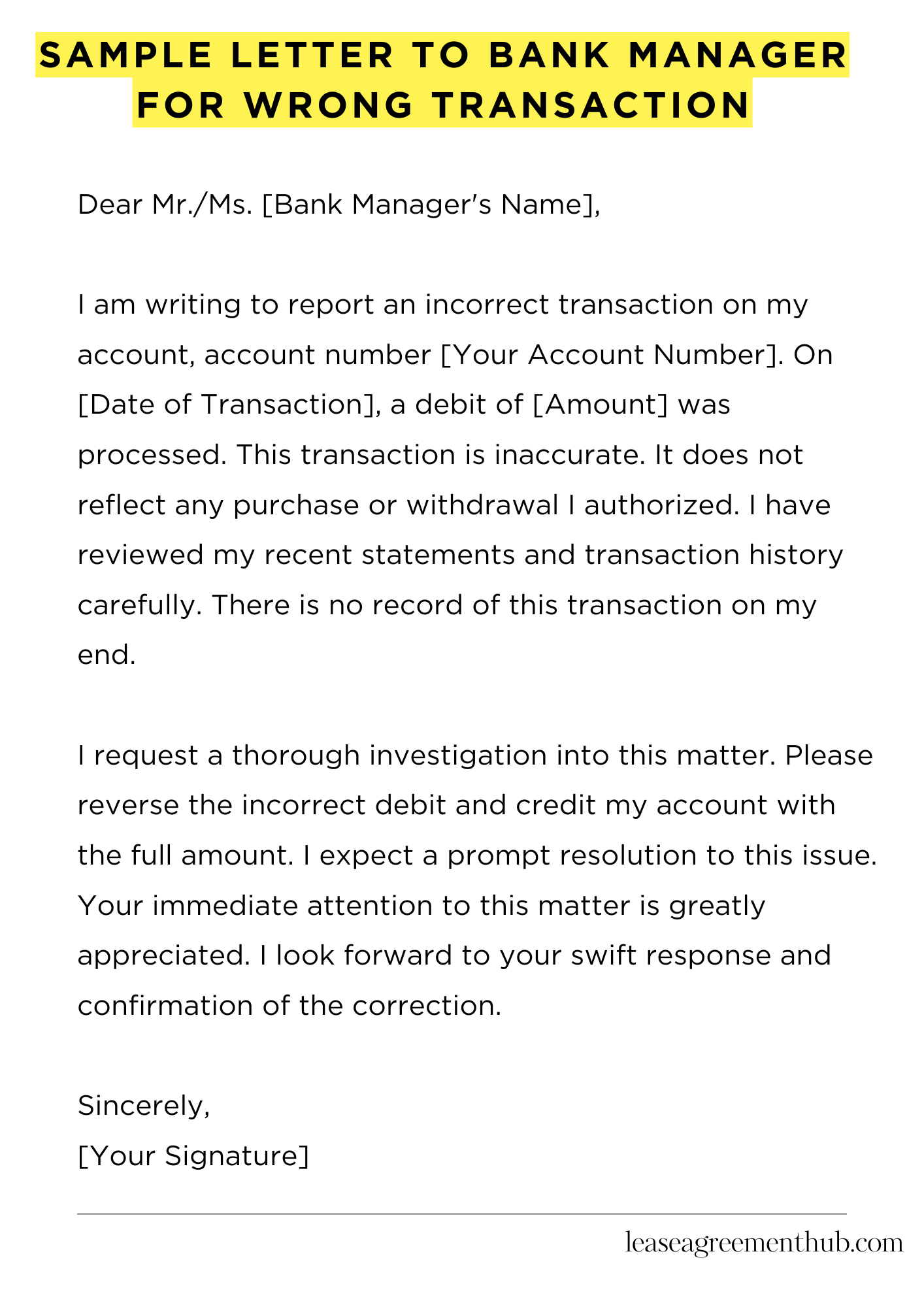Have you ever experienced a wrong transaction in your bank account? It can be frustrating, but writing a letter to your bank manager can help resolve the issue quickly and efficiently.
In this article, we will provide you with templates and examples of sample letters to bank managers for wrong transactions. These samples will make it easier for you to communicate your concerns and request a correction from the bank.
Whether you need to report a mistaken deposit, an unauthorized withdrawal, or any other type of error in your account, our sample letters will guide you on how to effectively address the situation with your bank manager. Stay tuned for helpful tips and examples to make the process smoother for you.
sample letter to bank manager for wrong transaction
[Your Name]
[Your Address]
[Your Phone Number]
[Your Email Address]
[Date]
[Bank Manager’s Name]
[Bank Name]
[Bank Address]
Dear Mr./Ms. [Bank Manager’s Name],
I am writing to report an incorrect transaction on my account, account number [Your Account Number]. On [Date of Transaction], a debit of [Amount] was processed. This transaction is inaccurate. It does not reflect any purchase or withdrawal I authorized. I have reviewed my recent statements and transaction history carefully. There is no record of this transaction on my end. I have attached copies of my recent statements as supporting documentation.
I request a thorough investigation into this matter. Please reverse the incorrect debit and credit my account with the full amount. I expect a prompt resolution to this issue. Your immediate attention to this matter is greatly appreciated. I look forward to your swift response and confirmation of the correction.
Sincerely,
[Your Signature]

How to Write a Sample Letter to Bank Manager for Wrong Transaction
Understanding the Gravity of the Situation
A banking error, especially concerning erroneous transactions, necessitates immediate and decisive action. Ignoring such discrepancies can lead to protracted disputes and significant financial ramifications. A well-crafted letter to your bank manager is your first step towards rectifying the situation. Precision and clarity are paramount.
Gathering Essential Information: A Prerequisite to Persuasion
Before embarking on the letter’s composition, meticulously gather all pertinent details. This includes the precise date and time of the erroneous transaction, the involved amounts, the account numbers affected, and any supporting documentation such as transaction slips or online banking statements. Accurate data forms the bedrock of your argument.
Structuring Your Case: A Roadmap to Resolution
Organize your letter logically. Begin with a formal salutation, addressing the bank manager by name if possible. Clearly state the purpose of your letter in the opening paragraph. Then, systematically present your evidence, chronologically detailing the events leading to the wrong transaction. Conclude with a clear request for resolution, specifying the desired outcome – be it a reversal, reimbursement, or an explanation. Avoid obfuscation; clarity is key.
Crafting Compelling Prose: The Art of Persuasion
Employ a formal yet assertive tone. Avoid accusatory language; instead, opt for a measured yet firm approach. Use precise language, eschewing vagueness or ambiguity. Support your claims with irrefutable evidence. Your letter should be a concise yet comprehensive exposition of the problem and your proposed solution.
Maintaining a Professional Demeanor: Projecting Confidence
Remember, your correspondence reflects on you. Maintain a professional and courteous demeanor throughout the letter. Even while asserting your rights, avoid rancor or invective. A measured tone is more likely to elicit a positive response than an intemperate one. Your goal is collaboration, not confrontation.
Ensuring Accuracy and Legibility: Avoiding Lacunae
Proofread your letter meticulously before sending it. Grammatical errors and typographical mistakes undermine your credibility. Ensure your letter is neatly typed or handwritten legibly. Include your contact information prominently. A polished letter demonstrates your seriousness and attention to detail.
Following Up: Ensuring Your Concerns Are Addressed
After sending the letter, allow a reasonable timeframe for a response. If you haven’t heard back within a week or two, follow up with a phone call or another letter. Persistence, coupled with politeness, increases the likelihood of a satisfactory resolution. Document all communication for your records.
FAQs about sample letter to bank manager for wrong transaction
What information should I include in my letter?
Your letter should clearly state the date of the incorrect transaction, the amount involved, the type of transaction (e.g., debit, credit, transfer), the correct details of the intended transaction (if applicable), and your account number. Include any supporting documentation references, such as transaction IDs or statements showing the discrepancy.
What is the best way to structure my letter?
A formal, business-like structure is recommended. Begin with a polite introduction, clearly stating your purpose. Present the details of the incorrect transaction concisely and factually. Conclude with a polite request for a resolution and your preferred method of contact.
How formal should my letter’s tone be?
Maintain a professional and respectful tone throughout. Avoid accusatory or emotional language. Focus on presenting the facts clearly and requesting a resolution in a courteous manner.
Should I send the letter via mail or email?
Both methods are acceptable. Check your bank’s preferred method of communication for formal complaints. If sending via email, ensure you use a professional email address and attach any relevant supporting documents.
What should I do if I don’t receive a response?
If you don’t receive a response within a reasonable timeframe (typically a week or two), follow up with a phone call to the bank manager’s office. If the issue remains unresolved, consider escalating the complaint through higher channels within the bank or to a relevant financial authority.
Related: